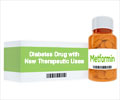A drug commonly used to treat type 2 diabetes has been found to increase the risk of pancreatitis in some patients and pancreatic cancer in long-term users, say researchers.
Researchers have found that long-term use of a drug commonly used to treat type 2 diabetes increases the risk of pancreatitis and pancreatic cancer in some patients.
The team led by Larry L. Hillblom Islet Research Centre at UCLA found that sitagliptin, sold in pill form as Januvia, caused abnormalities in the pancreas that are recognized as risk factors for pancreatitis and, with time, pancreatic cancer in humans.However, the adverse effects can be negated when combined with older diabetes drug.
Sitagliptin is a member of a new class of drugs that enhance the actions of the gut hormone known as glucagon-like peptide 1 (GLP-1), which has been shown to be effective in lowering blood sugar in diabetics.
"Type 2 diabetes is a lifelong disease - people often take the same drugs for many years, so any adverse effect that could over time increase the risk for pancreatic cancer would be a concern," said Dr. Peter Butler, director of the Hillblom Centre and the study's lead investigator.
"A concern here is that the unwanted effects of this drug on the pancreas would likely not be detected in humans unless the pancreas was removed and examined," he added.
During the study, the researchers used human IAPP transgenic (HIP) rats to test both sitagliptin and metformin.
Advertisement
The researchers sought to determine how the drugs, both singly and in combination, affected islet disease progression in the pancreas - particularly how they affected beta cells in the pancreas's Islets of Langerhans.
Advertisement
They found that the two drugs in combination had a synergistic effect that helped preserve beta cells, improved their function and enhanced insulin sensitivity in the test rats.
With the sitagliptin alone, however, the rats had abnormally high rates of cell production in their pancreatic ducts; a few developed an abnormality known as ductal metaplasia, and one developed pancreatitis.
However, metformin, trade name Glucophage, seems to counteract sitagliptin's adverse effect.
"The apparent protection against the unwanted actions of sitagliptin in the exocrine pancreas are intriguing and may offer a potential way of using the GLP-1 class of drugs safely," Butler said.
"The protective effect may have been either by the actions of metformin to decrease blood glucose values or its recently appreciated properties as a tumour suppressive agent," he added.
Butler noted that the present study was undertaken in rats and that it is possible the adverse effects observed would not occur in humans.
"Given these findings, it is probably sensible to use the GLP-1 class of drugs only with metformin until other data is forthcoming," he added.
The study was published in the online edition of the journal Diabetes.
Source-ANI
TAN/L














